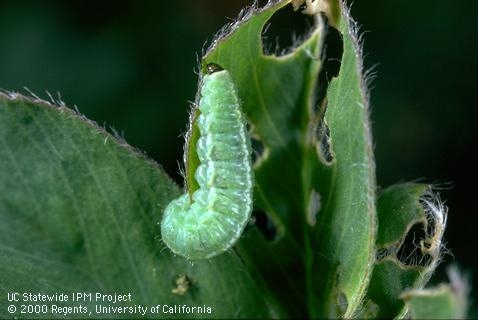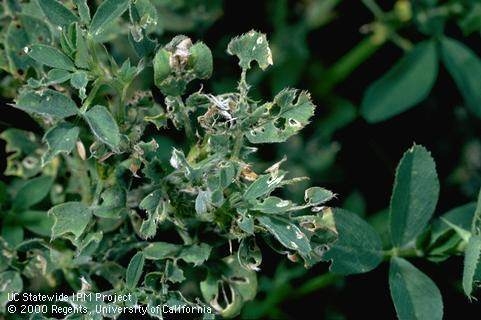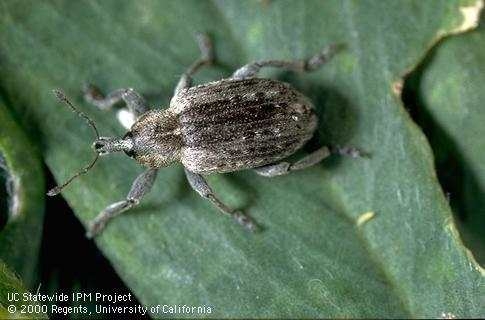- Author: Rachael Freeman Long
It’s that time of year again when we need to start thinking about controlling weevils in alfalfa hay production. Egyptian alfalfa weevils are the most damaging insect pests of alfalfa in California, as the larvae feed on the foliage, causing yield and quality losses if left untreated.
The life cycle of the Egyptian alfalfa weevil is predictable. Adults spend the summer outside fields in protected areas, such as behind tree bark (for example, eucalyptus trees) and in crevices. In late fall or early winter, adults emerge and migrate into alfalfa stands. Soon after entering fields, they begin laying eggs in new and old or dead alfalfa stems. Hatching larvae make their way to the terminal buds and feed on the developing foliage; larger larvae feed in more exposed sites such as on the leaflets. About 3-4 weeks later, the larvae spin a cocoon and pupate on the plant or ground, later emerging as adults. Egyptian alfalfa weevils have one generation a year, with most of the weevil damage occurring in late winter and early spring, depending on field location. Sometimes there may be a partial second generation with some new adults laying eggs that hatch, but most of the new adults leave the field right after emerging from the cocoon.
Management options are limited and primarily include the use of insecticides. Early harvest is usually not economical. Beneficial insects, including parasitoid wasps, are not present in fields in high enough numbers to prevent economic damage by the larvae. Sheeping off fields during winter for weed control helps reduce weevil pressure (sheep feed on and trample stems where weevils lay eggs) but cannot be relied on for weevil control.
There are a number of insecticides registered for use in alfalfa for weevil control (see the UC IPM guidelines for alfalfa at http://ipm.ucdavis.edu). These include chlorpyrifos (Lorsban and Lock-On, as well as Cobalt and Stallion that are mixtures of chlorpyrifos with other chemistries) as well as the pyrethroids and Steward (indoxacarb). Entrust (spinosad) is also available for organic alfalfa fields, giving about 70% weevil suppression.
For water quality protection in conventional alfalfa production where chlorpyrifos is a water quality problem in surface storm water and irrigation runoff, consider using the pyrethroids or Steward. Pyrethroids primarily move with sediments, which is not an issue for alfalfa production (except perhaps on the tail ends of fields where erosion may occur as water moves offsite), as alfalfa traps sediments. Steward does not give as long a residual control as pyrethroids (10-14 days depending on the rate), but works well against weevils and appears to be softer on beneficial insects.
Now is the time to begin monitoring alfalfa fields for weevils using a sweep net and looking for signs of larval feeding damage on the leaves. Treat fields when there’s an average of 20 weevil larvae per sweep in several (at least four) different areas of the field. However, lower thresholds may occur for shorter alfalfa, higher for alfalfa fields with more regrowth, so also watch for plant damage.
Future research for weevil control in alfalfa will focus on new insecticides for weevil control that have minimal environmental impacts.





Thanks
Jess
but Here FD 4 & 5 varieties have very little if any Weevil Damage while FD 7 & 8 varieties have enough damage that the damage can be seen from the road.
Here being 31ºN & 97º 20' W, Half way between San Antonio & Dallas TX and 10 miles East of I-35
Close Winter grazing has been found to greatly reduce weevil infestation - so yes this seems to be a good weevil strategy. Timing Us likely important. Watch excessive soil compaction it it starts raining.
Alfalfa is an insectary plant in that it has extra-floral nectaries (nectar sources outside the flowers) that attract beneficial insects to help control pests and reduce herbivory. This is likely one of the reasons that there are so many beneficial insects in alfalfa fields (and there’s plenty of pests for predators to feed on too, like aphids too). The only reason that we don’t promote alfalfa in insectary habitat plantings is that alfalfa is also a host of a number of different viruses that are problematic in other crops, such as alfalfa mosaic virus in tomatoes and dry beans as well as leaf scorch in almonds. The issue with biocontrol of alfalfa weevils by parasitoid wasps is that the alfalfa weevils frequently encapsulate and kill the wasp eggs when they’re laid inside the weevil larvae. Generalist predators aren’t effective enough, likely because the eggs are laid inside stems, protecting them. When a big hatch occurs, the predators can’t keep up, resulting in high numbers of weevils in fields.